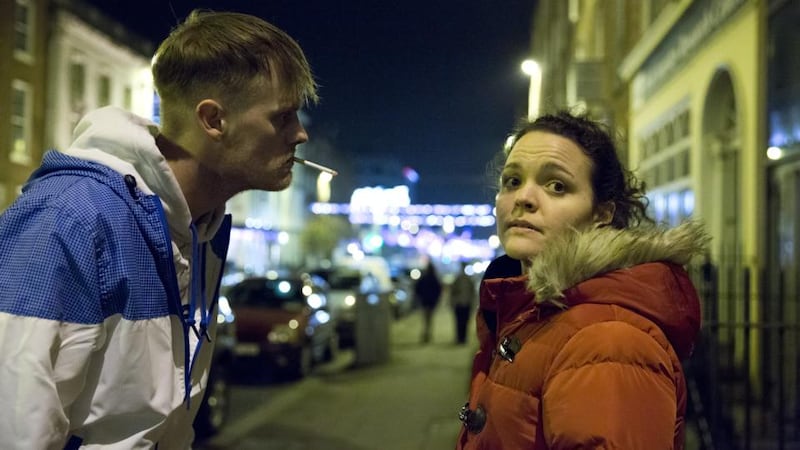The biggest event of Limerick’s year as National City of Culture had 250,000 people watching a giant granny move about a city, as she captivated hearts and imaginations with a magnetic charm.
Many of the other large shows were equally engaging, particularly the Irish premieres of Fuerza Bruta and NoFit State circus, staged at a former Dell computer factory. The year's €6 million programme, aimed at unlocking Limerick's cultural potential, even had a good old row at the start. But, for all the noise, it's only when Limerick begins to see what legacy it leaves that Ireland's first National City of Culture programme can be accurately judged.
The early days of 2014 were difficult. The programme's artistic director, Karl Wallace, resigned before the New Year's Eve grand opening, and he was followed by two senior programmers. Then the chief executive, Patricia Ryan, resigned.


Just three days into 2014 several hundred people attended an intense public meeting. There was anger about Wallace’s resignation and the manner of Ryan’s appointment. There was disgust that something so potentially positive for Limerick was in danger of being lost before it even started. The controversies prompted national debates about arts funding, cronyism and public-service meddling.
Mike Fitzpatrick, the widely respected head of Limerick School of Art and Design, was subsequently appointed to lead the project. "It was a really good programme, and it was in honour of the people who weren't here to be able to say we delivered that programme as set out," he says. "Everybody can take a lot of sustenance out of the collective effort that made it happen."
Fitzpatrick says the spending of the €6 million has been “documented very carefully”; the overall bill is likely to be closer to €10 million, with the shortfall covered through local-authority, corporate and philanthropic support. An estimated 750,000 people saw events during the year, which Fitzpatrick says is phenomenal for a city of 100,000 people. There are no official figures for a financial return yet, but a report by Grant Thornton puts it at €91 million over five years.
Mary Coll, the author, poet and former director of the Belltable Arts Centre, says one of the greatest legacies of Limerick's tenure as National City of Culture is the extent to which it united people working in the arts, who should be regarded as a professional resource.
“What I would hate to see happen now is that City Hall would breathe a big sigh of relief and think, Thank God that’s over: we made it to the finish line and nobody got hurt – now let’s not talk about arts and culture for a long time,” she says.
Giant granny
For Coll there were many highlights, including the visit of the eight-metre granny by the French theatre company Royal de Luxe. “The granny broke the equivalent of the glass ceiling for public participation in the arts in Limerick,” she says.
This street-theatre extravaganza was the centrepiece of Wallace's programme. The former minister for the arts Jimmy Deenihan dismissed it as "some puppet show" when it emerged that the board had refused to sanction it because of its price tag – about €1.3 million.
Katie Verling, who was the inaugural director of Glór Irish Music Centre, in Ennis, Co Clare, says she has become increasingly aware that a large percentage of the population has no access to the arts; although Limerick's programme began to change this, it is only the beginning of a process. "City of Culture was a very important investment in Limerick's community. Rebranding, that doesn't happen overnight. That will happen organically if the community itself is functioning as a good community."
City of Culture precipitated physical changes in Limerick city centre over the year, particularly with the opening up of many derelict buildings for exhibitions. "We moved from art collections to shows, to ballet, to pop-up museums and performances on boats and barges. We fell in love with the Brad Pitt Light Orchestra, in the amazing Spiegeltent during the Culture and Chips weekend, and were blown away with them again in the Unlucky Cabin Boy," says Jo O'Brien.
Together with seven local friends, she decided to see one cultural event each month during 2014. “For every one event we attended we missed four more. The city is alive. People are thinking differently about Limerick,” she says.
The Draw Out Project put urban artists' work on city buildings. There is particular affection for the giant portrait by Joe Caslin of a young man on the Ranks building.
"I live in the city and am always coming across tourists and locals taking pictures of the pieces. In fact I'd wager a bet that the Eye Scream piece, across from King John's Castle, is as photographed as its more illustrious neighbour," says Tara Robinson, who was involved in the Limerick Spring Festival of Politics and Ideas.
In total 109 projects were awarded €2.3 million under the Made in Limerick funding stream. Among the highlights was Are You Dancing?, when more than 3,000 people turned up to enjoy the music of Limerick's former dance halls on a summer's evening in June.
"I'm not sure if City of Culture did realise its full potential. But from where we started in January we have made huge strides throughout the year," says David Studer, who co-ordinated Are You Dancing?
Film Limerick is a legacy project that has already set in motion plans for a film-production hub in the city in association with Ardmore Studios. The Craft Hub, on Lower Cecil Street, which is working with more than 30 local practitioners, provides a shop, gallery, classroom and studio space.
The sonic artist John Greenwood curated the Pigtown Fling legacy project, which involved more than 50 local artists, from a tin-whistle busker to members of the Irish Chamber Orchestra, and is now working on its next project, Pig Iron. "A city needs to live and breathe, and the way it does it is through the arts. If you took the arts out of the city, what would the city be?" he says.
While the focus is now turning towards Limerick’s bid to be European City of Culture, some infrastructural issues have to be addressed. “Currently we don’t have a permanent director in the City Gallery of Art, and this is one of our prime visual-art institutions in the city. We also need to recruit a creative or artistic director for the Limerick City Arts and Cultural Centre,” says Coll.
Fill the vacuum
It has been reported that a creative agency will be set up in Limerick to fill the vacuum created by the end of the City of Culture year. The local authority says nothing has been confirmed, however.
“The legacy for 2015 is much more important than 2020. We can’t let everything go quiet now,” says the actor and director Liam O’Brien, of Bottom Dog Theatre Company.
“People involved have recognised the value of this year, from the most boring things, like bed nights, to the most important things, like kids walking up the streets and thinking, This is magic.”
Limerick’s reign comes to an end on December 27th with a winter carnival. There are no plans for a New Year’s Eve closing ceremony. “We want the idea that it’s ongoing, that it doesn’t end,” says Fitzpatrick. “There is a lot of interest in legacy now, and how that will be harvested, and obviously one manifestation is that we should have a really strong bid for European Capital of Culture 2020.”
Fitzpatrick, who says €750,000 was spent marketing the programme, believes one of the biggest changes over the past 12 months has been to the way people think.
“What has changed is in the minds and hearts, and ultimately that’s what it’s about. Now we can really begin to dream.”
Rows, resignations and ‘Riverdance’: A City of Culture timeline
July 3rd, 2012
Jimmy Deenihan, as minister for the arts, announces Limerick as first National City of Culture, for 2014.
January 7th, 2013
The former European Parliament president Pat Cox is announced as chairman of the board. The Riverdance composer Bill Whelan and the Ireland rugby player Paul O'Connell join him on the governing body.
March 12th, 2013
Karl Wallace is appointed the programme’s artistic director.
October 15th, 2013
The Government confirms €6 million in funding for City of Culture in the budget.
November 3rd, 2013
Patricia Ryan is confirmed as chief executive and the programme is unveiled. The Limerick woman had been an adviser to Cox, when he was in the European Parliament.
November 25th, 2013
Concerns surrounding Ryan’s appointment are raised by councillors at a monthly meeting of Limerick City Council.
November 26th, 2013
Limerick city and county manager Conn Murray accepts criticism over the appointment process. Murray says he "personally identified a number of potential candidates", including Ryan, and engaged with them in confidence.
December 31st, 2013
City of Culture is launched at a large New Year’s Eve outdoor concert. Rumours are rife that Wallace has resigned as artistic director.
January 3rd, 2014
Wallace issues a statement confirming his resignation, citing difficulties in communication and being sidelined in decision-making. Programmers Jo Mangan and Maeve McGrath also resign.
January 3rd, 2014
More than 500 people attend a public meeting at the Clarion Hotel, where anger is expressed over the resignations and the appointment of Ryan, after it emerges that her €120,000 contract was never advertised.
January 5th, 2014
Ryan steps down, saying the speculation had “regrettably compromised” her authority and capacity to lead the project.
January 7th, 2014
Mike Fitzpatrick of Limerick School of Art and Design confirmed as new interim head.
January 16th, 2014
First night of Riverdance's 20th-anniversary show at the University Sports Arena; 17,000 see it during its run.
March 2014
8,500 people see Richard Mosse’s exhibition The Enclave; 14,000 people attend Fuerza Bruta, at the Culture Factory, formerly a Dell computer complex.
April 4th, 2014 M
ike Fitzpatrick appointed director.
June 2014
Spiegeltent is brought to Limerick for the Culture and Chips Festival. Bianco, staged by the NoFit State circus company, premieres at the Culture Factory.
September 2014
Almost 250,000 people see the visit of Royal de Luxe’s granny during a three-day street theatre spectacle.
December 27th, 2014
City of Culture wrap party. Limerick Winter Carnival to take place around the city.










